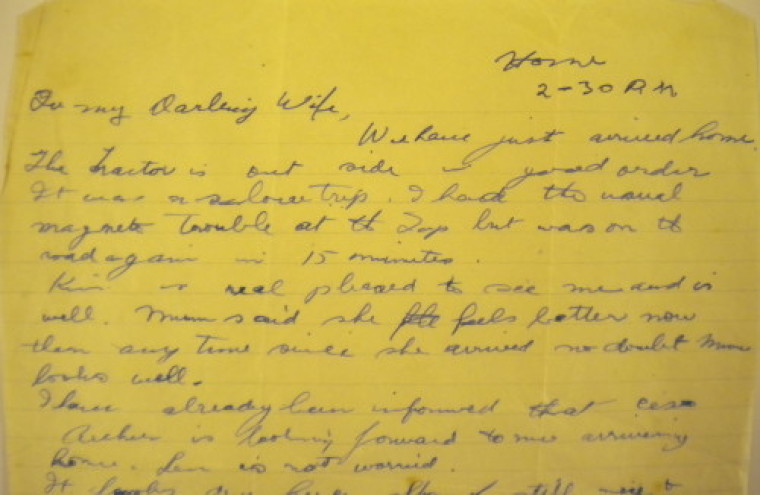
There are courtship letters written by my parents leading up to their marriage in 1947. There are letters to and from each other when my mother was in hospital for weeks-on-end in pregnancies and my father was on their farm, 60 miles away.
There are letters from my grandmother. There are letters from my father's eldest sister to whom he was fondly attached. There are letters from treasured friends to my mother; these were girl friends that were in the Land Army together during WWII. They remained friends over a life time and many letters were written. We know, we have them.
There are letters from family members from overseas. The lightweight 'aerogram' was a recent development in the 1950's and there are innumerable such 'air letters' from aunties in England to my mother, on their whispy blue paper.
There are a number of things we can say about such letters.
Handwritten letters were the usual form of communication in this era. Typewriters have never been a custom household item in Australia (as was a radio).
We can also attest that letter writing is an ancient craft. The Old and New Testaments frequently speak of letters, scrolls and documents. In the days up to the Industrial Revolution, where not everyone could read and write, people thought it so important to send personal messages that they employed scribes to write their letters for them on special occasions.
Seals became a major part of the security system of the time, and that would enable the recipient to be confident that the letter had not been tampered with if the seal was intact.
Another aspect of such letters is that they reveal the thinking and context of ordinary people in a particular decade.
My father writes of his 'dairy separator' as the first in the district. My mother writes of their Crediton farm house having the first septic toilet system in the district. When the local farmers and wives visited them for their 'tea kettling' party (welcome home after the honeymoon), the ladies checked out the new fangled 'chain' operated toilet. Soon after, we learnt from the letters, every farm house had a septic system.
The style of letters changed over the years. Even today, I would never initiate a letter to my wife without mentioning her name. Yet there is a consistency within these letters with the words: "To my darling wife". "To my friend". "To my niece". "To Auntie". "To Mother and Father" ….
A most important event of every week day in Australia was the delivery of the mail. There were huge fines and jail sentences associated with interfering with the Royal Mail.
The entire nation survived on mail deliveries. We have little idea today as to how important the mail was to everyone in Australia. This was still an era where England was considered 'home' even if you never had been there. Getting mail from 'home' for generations of Australians was paramount to national comfort and general well-being.
These letters were very personalised. Intimacy could be generated by the use of a single word; letters were carefully crafted and could be of a mesmerising nature. The pace of life was slower, it might take a letter a week to get from the city to a farming district. 'Courting letters' were very precious where every word was seasoned.
Today, we live in a different era. The internet, emailing, facebook and twitter have all played their part in abbreviating sentences. When someone sends you a handwritten letter today, it is regarded as perhaps a little special.
In our faith-financed mission, I have maintained a process of hand-writing. Often when asking for funds for a special project, I will write the letters by hand. When receipting gifting, I will hand write a thank you note. When my wife Delma hand crafts cards for my ministry, I always add a personal note to the recipient.
There is still a lot to be said for hand-writing letters, albeit in a different context in 2010 than those carefully crafted in the family archive chest.
And by the way, I do have a 'seal' and use it occasionally. It is the letter 'T' as one might expect. Some years ago my eldest daughter and I were in a craft shop and my birthday was coming up, and I spied the wax and a selection of seals.
I discovered that placing a seal on the fold of an envelope takes a little getting used to. I burnt my fingers the first couple of times as I hadn't scored the angle right for the hot wax to gently spread over the envelope's fold.
Once I got that right, placing the T seal on the wax I found had to be done there and then. Our local Post Office people tell me that when placing mail into the PO Boxes they often see seals. They seem to be more common than one might imagine, even in 2010.